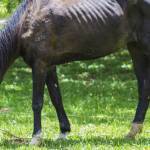Bulking Up

Numerical scoring is the most widely accepted standardized method of assessing body condition in applied, horses. Though different systems exist, the most common uses a scale of 1 to 9, with 1 denoting emaciation and 9 designating obesity when this method is practiced and consistently body condition scoring provides a reliable means of monitoring body weight.
Horses gain and lose weight through variations in energy intake and energy expenditure. Increases in energy intake without a simultaneous increase in energy expenditure will likely result in weight gain. On the contrary, a prolonged increase in energy expenditure, which might occur with a more demanding workload or harsh environmental conditions, without a corresponding boost in energy intake will usually end in weight loss. Increasing the body mass of horses through weight gain is a particularly timely topic because more horses are turning up in rescue situations and a clear understanding of weight gain and changes in body condition are warranted.
Achieving weight gain, and thus an increase in body condition, depends largely on the maturity of the horse. The amount of digestible energy (DE) needed for weight gain increases as horses age. Though the amount of DE above maintenance requirements needed for each kilogram of gain has not been researched extensively, a few studies offer a solid foundation on which to base recommendations.
Researchers found that mature horses required about 24 Mcal DE above maintenance for each kilogram of gain. In another study performed at approximately the same time, other researchers using Standardbred geldings estimated that 0.99 Mcal metabolizable energy (ME) per day above maintenance requirements was necessary to achieve a gain of 5-6 kg (11-13.4 pounds) over a three-month period. This equates to about 18 Mcal DE/kg gain. Another group of scientists measured DE intake of Belgian and Percheron horses, and indicated that 16-20.7 Mcal DE beyond maintenance were needed per kilogram (2.3 pounds) gain. Using these studies, it seems that approximately 16-25 Mcal DE are required for every kilogram of gain. But how much gain is necessary to achieve a change in body condition?
This too is an area of little study. Some nutritionists estimated that weight gains of 33- 45 kg (72-99 pounds) were linked with an increase of about two condition score increments (from 4 to 6, for example). Therefore, each increment requires about 16-20 kg (35-44 pounds) of weight gain. Other researchers reported a much higher value per incremental change in condition score. They indicated that condition scores of Thoroughbred geldings that gained 93 kg (205 pounds) increased from 4.3 to 7, suggesting approximately 34 kg (74 pounds) of gain were associated with each incremental increase in condition score. Nutrient Requirement of Horses suggests that a weight gain of 16-20 kg (35-44 pounds) will increase the body condition of a 500-kg (1,100-pound) horse from a four to a five. Obviously, there is some variance among the results of these studies; thus, pinpointing an exact value is impossible.
A realistic timeline for weight gain must be established, as changes in body weight occur slowly. Weight-gain goals should be measured in months, not weeks. Trying to add weight too quickly might predispose a horse to potentially life-threatening problems such as colic and laminitis, as well as other health risks caused by high-grain diets such as subclinical acidosis. To achieve reasonable weight gain, a moderate increase in DE intake above maintenance requirements is ideal.
Using the assumption that one incremental change in condition score requires 16-20 kg (35-44 pounds) of gain and that 1 kg (2 pounds) of gain requires 20 Mcal DE above maintenance, body condition can be elevated one score in as little as 60 days by increasing the percentage of DE above maintenance by 32-41%. The percentage DE required for gain drops as more time is allotted for weight increases. The same amount of weight gain can be achieved in 180 days by a much slighter increase in DE above maintenance, just an average of 2 Mcal, or 11-14% increase in DE above maintenance.
In the proceedings of the 2008 Kentucky Equine Research Nutrition Conference, noted equine nutritionist Laurie Lawrence, Ph.D., estimated the DE above maintenance necessary to achieve weight gain over different periods of time. She used as her model a 500-kg (1,100-pound) horse at maintenance with a target weight of 525 kg (1,157 pounds). Based on the preceding information, a weight gain of 25 kg (55 pounds) should result in a one point change in condition score. Without large quantities of concentrate and high-quality forage, it is likely impossible to achieve the desired 25-kg gain in 30 days.
Whereas a horse on the 30-day plan might have to consume 6-8 kg (13-17 pounds) of concentrate a day as well as high-quality forage, the same horse on the 90-day plan could consume 2-3 kg (4-6 pounds) concentrate and 10 kg (22 pounds) of good-quality forage for identical weight gain. Small concentrate meals are more conducive to gastrointestinal health. Therefore, a long-range plan for weight gain is most beneficial to the well-being of the horse. Exercise increases the total DE required above maintenance for weight gain. If a horse is to be exercised, more time should be built into the weight-gain schedule.








